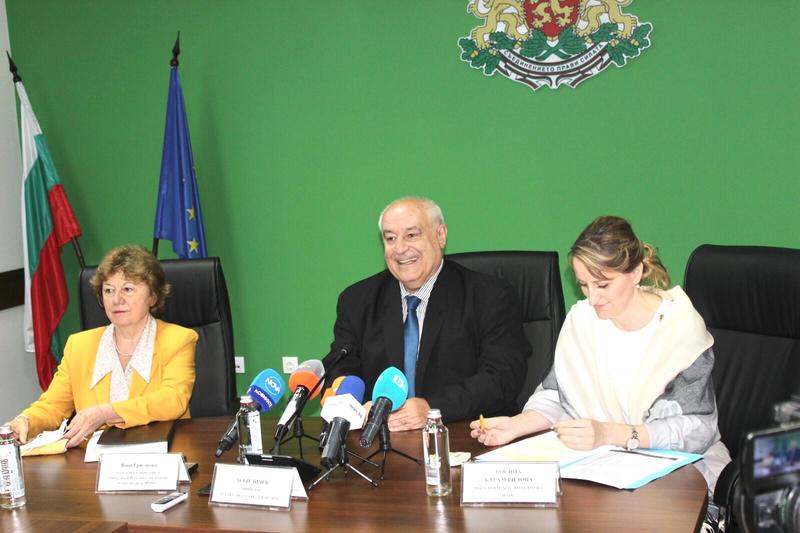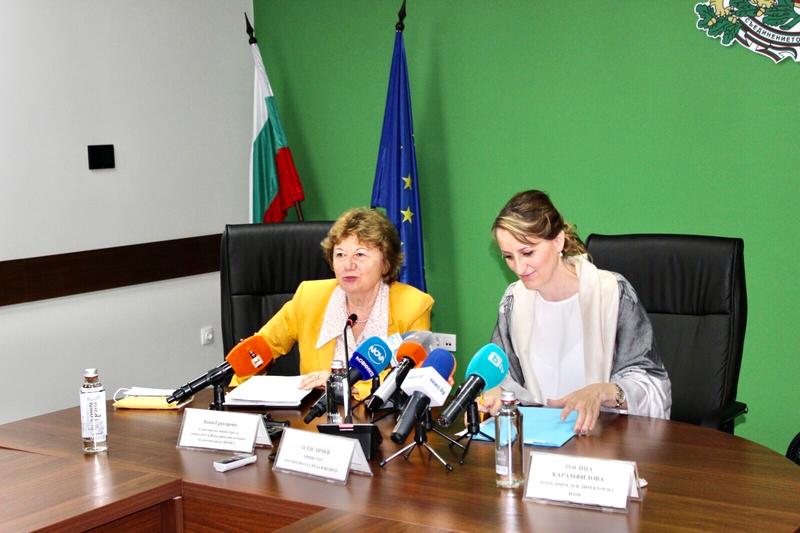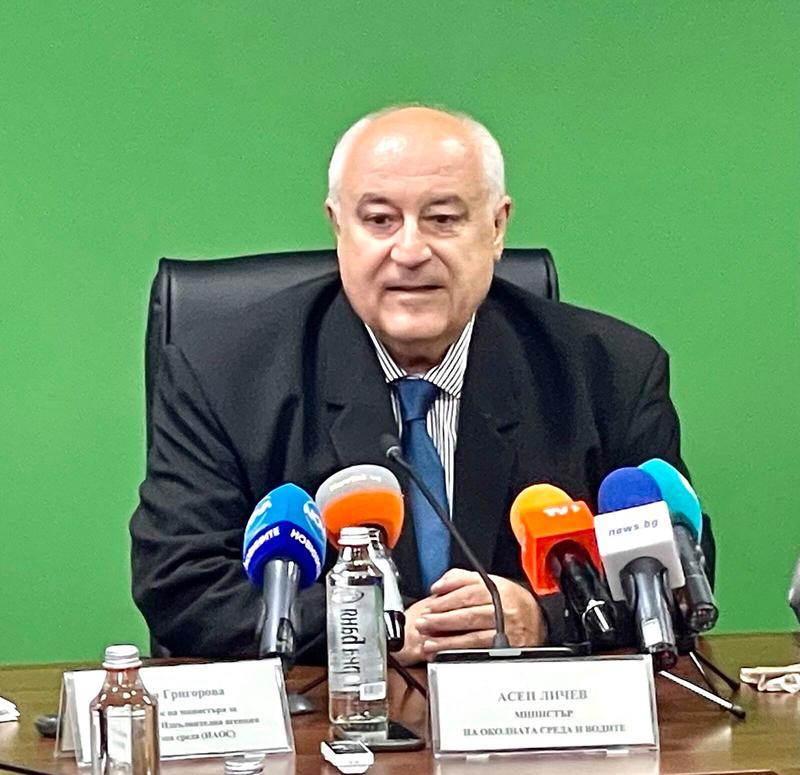Minister Asen Lichev: Over 500 000 BGN in additional financial incentives have been given out to OPE in April
28 May, 2021 | 15:33Minister Asen Lichev: Over 500 000 BGN in additional financial incentives have been given out to OPE in April
28 May 2021 / 15:33
Today my colleagues have the pleasure to present to you the so-called “Green book”, which is an assessment of the state of the environment for 2019. Before that, I want to share with you that yesterday we sent a letter to the Council of Ministers on how the environmental legislation is to be implemented, including that of the Biodiversity Act, with regard to the Recovery and Resilience Plan. We have also provided the shortest possible procedure so as not to hinder the government's efforts. Something surprised me today. Although the bag of money has been emptied here, various documents are still popping out. One popped out today, from which it became clear that in April Minister Emil Dimitrov approved additional financial incentives for General Directorate “OPE” in the amount of over 500,000 BGN. This is an increase of 200%, with an average percentage of such incentives in addition to monthly wages for the administration of the Ministry of 40%. Probably because OPE had rejected two tasks that contributed to the Ministry's deficit of 8.5 million BGN. This story is still under investigation. We will acquaint you with details on the case later.
I have not given up on stopping the import of waste. Despite indications of external pressure, that is rather of unhealthy character. I continue the preparation, as I have planned in accordance with the Environmental Act, the Waste Management Act, and the Constitution of Bulgaria, the Basel Convention and the EU Waste Regulation.
I present to you Rositsa Karamfilova, Executive Director of the Executive Environment Agency (EEA), who together with Vanya Grigorava, my EEA Advisor, will present the Green book. There is a paradox here that you will notice. The conclusions on waste in particular. Please inquire in detail why this is the case. Thank you!
Executive Director of the EEA Rositsa Karamfilova:
I will try to summarize the National report on the state and protection of the environment, to present a breakdown of the main trends, the main problems, and challenges and in general the state of the environment in 2019.
The report was already adopted this Wednesday by the Council of Ministers. It will be publicly available and uploaded on the EEA website. In addition, each of you received it on a disk, the document is about 300 pages.
We want you to know that all previous reports have been uploaded on the EEA website. The report contains 16 sections, I will focus on brief details from each section. Each of the sections includes key questions, answers, and messages. Accompanied by good visualizations. The report was prepared by a joint group with leading experts from the MOEW and the EEA, and other institutions.
Section 1 “Emissions and air quality”.
The trend that we observe for the past 29 years is that emissions by main pollutants decrease, with the exception of PM2.5, whereby the report concludes that the reason for the increase is combustion processes in households.
PM10 pollution continues to be a major problem for air quality in the country and the percentage of the population living with PM10 pollution levels above the permissible norms is very high, i.e. 60.8%.
Section 2 is “Climate change”. Here we have a significantly positive trend, as for the period 1988-2019, emissions of major greenhouse gases tend to decrease.
Section 3, which is described in great detail in the Green book, is “Water Resources Management and Water Quality”. Here I want to note 3 important things. The number of operating municipal waste water treatment plants has increased from 78 (2010) to 173 (2019) and the population share covered by the services of waste water treatment plants has increased from 47.8% (2010) to 64.6% (2019).
In 2019 there is a continuing trend of improving the quality of surface water in the country in terms of basic physico-chemical indicators, both in the short and long term.
In general, it can be summarized that in 2018-2019 and before, the cross-section shows the preservation of surface water qualities in relation to the main indicators, and some even have a slight improvement.
Section 4 “Land use and soil condition”
In the period 2009-2019 there is a steady trend of increasing and maintaining the territory of areas of arable land and reducing the areas with uncultivated land.
The soils in the country are in good ecological condition in terms of supply of nutrients/organic matter, as well as in terms of pollution with heavy metals, metalloids, and persistent organic pollutants.
Section 5 “Biodiversity. National Ecological Network. Ecosystems”
For the period 2004-2019 the territory of protected areas has increased, and at the end of the year the number of protected areas is 1,017 with a total territory of 584,921.8 ha or 5.27% of the country’s territory.
I would like to make a comparison with 2018. In Bulgaria by the end of 2018, the Council of Ministers had approved 339 protected areas (352 in number, but 13 have common borders under the two directives) of the Natura 2000 network, covering a total of 34.4% of the country’s territory. In 2019 their number increased to 341 protected areas (354 in number, but 13 have common borders under the two directives) of the Natura 2000 network, covering a total of 34.9% of the country’s territory.
The report also presents populations of brown bears and chamois. You will find interesting facts and details in the report.
Section 6 “Forests“
Regarding atmospheric pollutants, in 2019 in the three test areas for intensive forest monitoring no exceedances of the critical quantities of acidity, sulfur, and nitrogen were registered.
The summarized assessment of the health status of forest ecosystems in Bulgaria shows a significant improvement in 2019 compared to previous years.
Section 7 “Waste and material resources”
The data have not been analyzed yet. The reason for the delay with the analysis is the accumulated lack of expertise and a serious postponement in the implementation of a number of regulatory obligations in the field of waste. We have created the necessary organization to overcome these challenges.
Section 8 “Radiation characteristics of the environment”
There is no tendency for increase in the volume of specific activity of natural and man-made radionuclides in the air.
The results of the completed radiological monitoring in 2019, compared to the results of previous years, do not show unfavorable trends in radiation and the ecological status in the “monitored” area of Kozloduy NPP EAD in result of the operation of the nuclear power plant.
Section 9 “Environmental noise”
Of the 486 industrial sources of noise inspected with regard to the noise emitted in the environment, only 5 were found to exceed the regulatory requirements and these were given instructions in this respect.
Section 10 “Energy”
In 2019, there is a decrease of 0.5% in final energy consumption compared to 2018.
In 2019 there is a decrease by 0.8% of the gross domestic consumption of fuels and energy in the country compared to 2018.
Section 11 “Transport”
The emissions of CO2 in the atmospheric air from transport in 2019 have decreased almost three times compared to emissions in 2000 and by 8% compared to those in 2018.
Section 12 “Financing of environmental protection activities”, section 13 “Operational Program Environment 2014 – 2020” and section 14 “Enterprise for management of environmental protection activities (EMEPA)” are the so-called financial instruments in the field of environment.
The costs for environmental protection and restoration at the national level are estimated at 2,308.05 million BGN, and their relative share of the gross domestic product (GDP) is 1.93%. This is the highest level of annual costs for the period 2016 - 2019.
The percentage of the agreed funds in relation to the total financial resources of Operational Program Environment 2014 - 2020 at the end of 2019 is 92.3% or 3.2 billion BGN. At the end of 2019 the funds utilized by the beneficiaries are approximately 936 million BGN, which amounts to 29.3% of the agreed funds under the program.
The received funds in the EMEPA account, coming from various sources for 2019, amount to 82,090,756 BGN.
Section 15 “Preventive tools for integrating environmental objectives into investment projects and existing installations”
The trend of recent years has been preserved of compliance by contractors with legislative requirements and the administrative acts issued for environmental impact assessment and environmental assessment.
There is an increase in the number of EMAS registered organizations and the number of Bulgarian products with the EU Ecolabel.
Section 16 “Raising environmental awareness and culture”
587 forums, seminars, talks, round tables, conferences for students, teachers, the business, non-governmental organizations, employees of MOEW municipal and state administration and its structures were held.
Over 33,000 children and students from 769 kindergartens and schools are covered by information and educational initiatives by the MOEW and its structures.
In 2019, compared to 2018, the number of visitors to the websites of the MOEW and its structures has increased, as has the number of discussions held with participation by the public.


